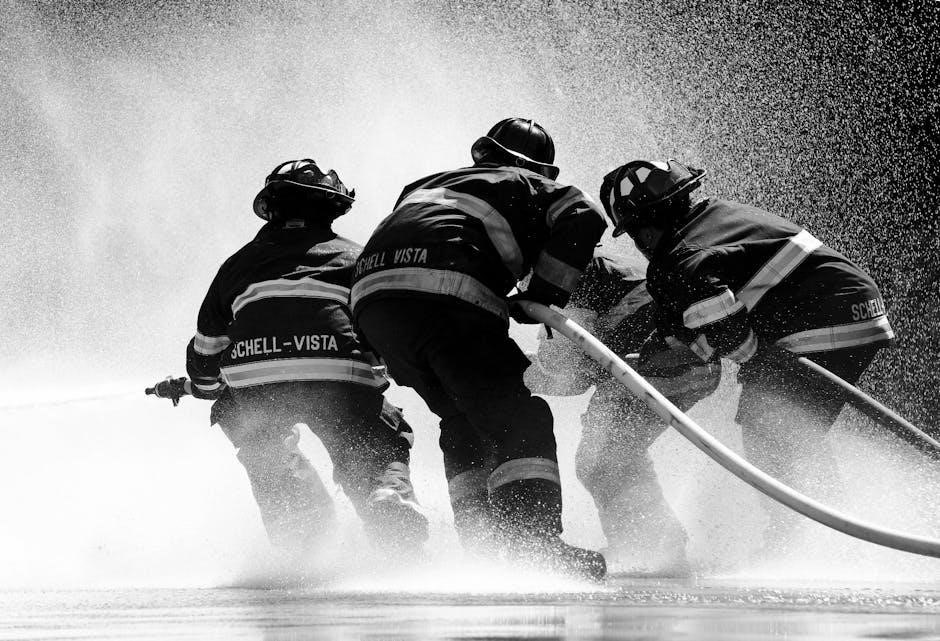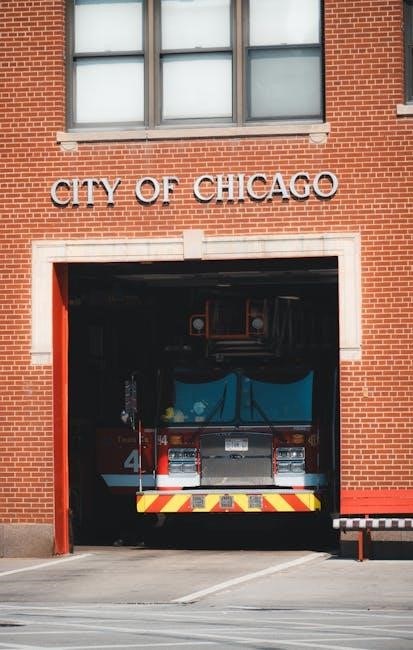A safety letter for a trucking company is a formal document addressing safety performance, compliance, and corrective actions. It ensures adherence to regulations and promotes a culture of safety within the organization, safeguarding drivers, vehicles, and public roads.
1.1 Purpose of a Safety Letter
A safety letter for a trucking company serves to inform the recipient about their current safety performance, outline steps to view and correct their safety record, and provide guidance for improvement. It confirms discussions regarding safety compliance and ensures adherence to regulations. The letter may also address corrective actions, such as improving driver training or vehicle maintenance, to enhance overall safety standards. Its primary goal is to promote a safer operating environment, protect drivers and public safety, and ensure compliance with industry regulations and standards.
1.2 Importance of Safety in the Trucking Industry
Safety is paramount in the trucking industry to protect drivers, passengers, and the public. Accidents involving trucks can have severe consequences, including fatalities and significant property damage. Proper safety measures ensure compliance with regulations, reduce liability risks, and maintain a company’s reputation. Regular vehicle inspections, driver training, and adherence to safety protocols are essential. A strong safety culture also improves CSA scores and avoids penalties. By prioritizing safety, trucking companies contribute to safer roads, reduce operational costs, and foster a responsible and reliable transportation network.

Structure of a Safety Letter
A safety letter structure includes a heading with company info, recipient details, a clear subject line, a concise body outlining safety concerns, and a professional closing.
2.1 Heading and Company Information
The heading of a safety letter should prominently display the trucking company’s name, address, and contact information. This establishes credibility and professionalism. Below the company name, include the date of the letter. The recipient’s name and address should be clearly stated to ensure the letter is directed to the correct individual. Including the driver’s name, if applicable, adds specificity. The heading should also reflect the company’s branding, such as a logo, to maintain a professional appearance. This section sets the tone for the formal communication that follows.
2.2 Recipient Details
The recipient details section must clearly state the name, title, and address of the person or department receiving the safety letter. For drivers, include their full name, driver’s license number, and any relevant ID numbers. If addressed to a manager or safety officer, specify their role and department. This ensures the letter is directed to the correct individual or team, maintaining clarity and accountability. Accurate recipient information is essential for professional communication and proper documentation, ensuring the safety message is delivered effectively. This section should be concise and free of errors to avoid misunderstandings.
2.3 Subject Line
The subject line of a safety letter should be clear, concise, and specific to grab the recipient’s attention immediately. It should reflect the purpose of the letter, such as “Safety Performance Review” or “Corrective Actions Required.” Including specific details, like the date or incident reference, adds clarity. The subject line must be professional and free of jargon to ensure the recipient understands the importance of the letter. A well-crafted subject line enhances the credibility of the communication and ensures the message is taken seriously. It should align with the overall tone of the letter and comply with industry standards.
2.4 Body of the Letter

The body of the safety letter should be structured to clearly convey the message while maintaining professionalism. It typically begins with a formal greeting, followed by a concise statement of the letter’s purpose. Specific details, such as incidents or areas of concern, should be outlined clearly. Corrective actions or recommendations are then presented, often with a timeline for implementation. The tone should remain collaborative, emphasizing shared goals of safety and compliance. Supporting documentation, like accident reports or inspection results, may be referenced. The letter should conclude with a call to action, such as requesting a response or implementing changes.

Key Components of a Safety Letter
A safety letter for a trucking company should include clear policy statements, performance reviews, corrective actions, and references to relevant safety regulations to ensure compliance and accountability.
3.1 Company Safety Policy Statement

A company safety policy statement outlines the organization’s commitment to safety in the trucking industry. It should clearly define the company’s safety culture, expectations, and adherence to federal and state regulations. This section emphasizes the importance of safety as a shared responsibility among drivers, management, and support staff. The policy should be concise, yet comprehensive, ensuring all stakeholders understand their roles in maintaining a safe operating environment. It serves as the foundation for all safety-related decisions and actions within the company, fostering a culture of accountability and continuous improvement.
3.2 Current Safety Performance Review
A current safety performance review provides an overview of the company’s recent safety metrics and compliance status. This section includes data on accident rates, inspection results, and any violations or citations. It compares the company’s performance against industry standards and highlights areas of improvement. The review also acknowledges positive trends, such as reduced incidents or improved driver compliance. Specific data points, like accident rates per mile or hours of service violations, are included to demonstrate transparency and accountability. This analysis helps identify patterns and informs future safety initiatives.
3.3 Corrective Actions and Recommendations
This section outlines specific corrective actions and recommendations to address safety concerns identified in the performance review. It includes actionable steps, such as additional driver training, vehicle maintenance improvements, or updated safety protocols. Recommendations are tailored to the company’s unique needs and may involve adopting new technologies or enhancing incident reporting processes. The letter also assigns responsibility for implementing these measures and establishes timelines for completion. By providing clear, measurable solutions, the safety letter ensures proactive steps are taken to mitigate risks and improve overall safety performance. Documentation and follow-up are emphasized to track progress.
3.4 Reference to Relevant Safety Regulations
This section ensures compliance by referencing key safety regulations governing the trucking industry. It cites specific federal and state laws, such as those from the FMCSA, OSHA, and DOT. Regulations addressing hours of service, vehicle maintenance, and driver qualifications are highlighted. The letter aligns company policies with these standards, ensuring adherence to legal requirements. Proper citation of safety regulations reinforces the importance of compliance and helps avoid potential violations. This section provides a clear framework for understanding and implementing safety measures in accordance with industry standards and legal obligations.
Legal and Compliance Aspects
Safety letters ensure compliance with federal and state laws, maintaining operational integrity and regulatory standards to prevent penalties and ensure safe practices within the trucking industry.
4.1 FMCSA Guidelines for Safety Letters
The FMCSA provides specific guidelines for safety letters to ensure compliance with federal regulations. These letters must include details on violations, corrective actions, and timelines for resolution. Companies must maintain accurate records and adhere to safety standards outlined by the FMCSA. Non-compliance can result in penalties, fines, or even operational shutdowns. The guidelines emphasize transparency, accountability, and prompt action to address safety concerns. By following FMCSA protocols, trucking companies can ensure regulatory adherence and minimize legal risks. Proper documentation and timely responses are critical to maintaining compliance and avoiding further enforcement actions.
4.2 Consequences of Non-Compliance
Non-compliance with safety regulations can lead to severe consequences for trucking companies. These include hefty fines, increased insurance costs, and damage to the company’s reputation. The FMCSA may impose penalties, such as civil fines or even revocation of operating authority. Additionally, non-compliance can negatively impact CSA scores, making it harder to secure contracts. In extreme cases, vehicles may be placed out of service, disrupting operations. Legal actions and settlements further amplify financial burdens. Companies must prioritize compliance to avoid these repercussions and maintain operational integrity.
4.3 Role of Safety Letters in CSA Scores
Safety letters play a crucial role in influencing CSA scores, as they provide insights into a trucking company’s safety performance. These letters highlight compliance issues, violations, and areas for improvement, directly impacting the carrier’s score. A poor safety letter can lead to lower CSA scores, increasing the risk of audits and interventions. Conversely, demonstrating corrective actions and improved safety practices can enhance scores. Regular reviews of safety letters help companies identify and address potential issues, fostering better overall safety and compliance. This proactive approach is essential for maintaining favorable CSA scores and reducing regulatory scrutiny.

How to Write a Safety Letter
When writing a safety letter, ensure clarity and conciseness, include supporting documents, and tailor the tone to foster a culture of safety and compliance.
5.1 Understanding the Audience
Understanding the audience is crucial when drafting a safety letter for a trucking company. The primary recipients may include drivers, safety managers, or regulatory bodies. Tailor the language to match their expertise and concerns. For drivers, emphasize clear, actionable safety protocols. For management, focus on compliance and strategic improvements. Ensure the tone is professional yet approachable, fostering a culture of safety. Addressing specific roles ensures the message resonates effectively, promoting adherence to safety standards and regulatory requirements. Recognizing the audience’s needs enables precise communication, enhancing overall safety and compliance efforts within the organization.
5.2 Clarity and Conciseness in Writing
Clarity and conciseness are essential in safety letters to ensure the message is quickly understood. Avoid using overly complex language or jargon, as this can confuse the reader. Instead, use straightforward sentences that clearly convey safety expectations, policies, or actions required. Be direct and precise, eliminating unnecessary words or phrases. This approach ensures the audience grasps the critical information without misinterpretation. Clear writing also enhances professionalism and credibility, making the letter more effective in addressing safety concerns and fostering a culture of compliance and responsibility within the organization.
5.3 Including Supporting Documentation
Including supporting documentation in a safety letter strengthens its impact and credibility. Attach relevant records, such as driver training certificates, inspection reports, or incident analyses, to provide evidence of compliance or areas needing improvement. Clearly label each document and reference it within the letter to ensure the recipient can easily access and understand the supporting materials. This practice enhances transparency, builds trust, and demonstrates a commitment to safety. Proper documentation also serves as a valuable resource for auditing and compliance purposes, ensuring all safety measures are verifiable and up to standard.

Tools and Resources for Editing Safety Letters
Use PDF editing software like Adobe Acrobat or online tools like pdfFiller to modify safety letters. Utilize templates from websites like Template.net for professional formatting. Mobile apps like CamScanner simplify document scanning and sharing, ensuring efficient editing and management of safety letters.
6.1 PDF Editing Software (e.g., pdfFiller, DocHub)

PDF editing software like pdfFiller and DocHub are essential for modifying safety letters. These tools allow users to edit text, add signatures, and fill out forms directly in PDF format. They offer intuitive interfaces for easy navigation, enabling quick adjustments to safety policies or corrective actions. Many of these tools support real-time collaboration, making it easier for teams to review and finalize documents. They also provide version control, ensuring that the latest updates are always accessible. Mobile compatibility and cloud storage further enhance their utility for trucking companies managing safety letters on the go. These tools are indispensable for creating and managing professional, compliant safety documents efficiently.
6.2 Online Templates for Safety Letters
Online templates for safety letters provide trucking companies with pre-designed, customizable documents that streamline the creation process. These templates often include sections for company details, recipient information, and specific safety guidelines. Platforms like Template.net and Legaltemplates.net offer downloadable templates tailored for the trucking industry. They ensure compliance with FMCSA regulations and industry standards. Customization options allow companies to tailor the content to their specific needs, such as incorporating company policies or incident details. Using these templates saves time and ensures a professional, structured format for communicating safety protocols effectively.
6.3 Mobile Apps for Document Management
Mobile apps for document management are essential tools for trucking companies to handle safety letters efficiently. Apps like CamScanner and Adobe Acrobat allow users to scan, store, and share documents on the go. Evernote and Google Drive enable cloud-based storage and real-time collaboration. These apps support PDF editing, digital signatures, and task assignments, streamlining workflows. They also provide secure access to safety letters, ensuring compliance and timely communication. By integrating these apps, companies can manage safety-related documentation more effectively, reducing paperwork and enhancing overall operational efficiency while maintaining regulatory standards.

Best Practices for Implementing Safety Measures
Best practices for implementing safety measures include regular vehicle inspections, ongoing driver training, and strict adherence to safety protocols to reduce accidents and enhance safety culture.

7.1 Driver Training Programs
Effective driver training programs are essential for maintaining safety standards in the trucking industry. These programs should include regular sessions on defensive driving techniques, hazard recognition, and compliance with traffic laws. Training should also cover the proper use of safety equipment and adherence to company-specific safety protocols. Additionally, programs should address driver fatigue management, emergency procedures, and vehicle inspection routines. Continuous training helps drivers stay updated on best practices and reduces the risk of accidents. Investing in comprehensive training fosters a culture of safety and ensures compliance with industry regulations, ultimately protecting both drivers and the public.
7.2 Vehicle Maintenance and Inspection Procedures
Regular vehicle maintenance and inspection procedures are critical for ensuring road safety and preventing mechanical failures. Pre-trip and post-trip inspections should be mandatory, focusing on brakes, tires, lights, and fluid levels. Companies must maintain detailed records of all maintenance activities, including dates and repairs made. Drivers should be trained to identify potential issues during inspections. Adhering to a scheduled maintenance plan helps reduce breakdowns and improves overall fleet safety. Proper documentation of these procedures ensures compliance with FMCSA regulations and demonstrates a commitment to safety, reducing liability risks and protecting both drivers and the public.
7.3 Incident Reporting and Management
Effective incident reporting and management are essential for maintaining safety standards in the trucking industry. All incidents, regardless of severity, must be documented promptly and thoroughly. Drivers should be trained to report accidents, near-misses, or equipment failures immediately. Companies should establish a clear procedure for submitting incident reports, including details like dates, locations, and circumstances. Analysis of these reports helps identify trends and root causes, enabling corrective actions to prevent future occurrences. Proper management of incidents ensures compliance with FMCSA regulations and fosters a culture of safety and accountability within the organization.
A safety letter underscores the trucking company’s commitment to compliance, driver training, and incident management, fostering a culture of safety, reputation, and operational efficiency.
8.1 Final Thoughts on Safety Letters
Safety letters are crucial for maintaining compliance, improving driver behavior, and preventing incidents. They ensure clear communication of safety expectations and foster a culture of accountability. Regular reviews and updates help trucking companies stay aligned with regulations, reducing risks and enhancing operational efficiency. Ultimately, safety letters are a proactive tool for safeguarding drivers, cargo, and public safety while upholding the company’s reputation and commitment to excellence in the industry.
8.2 Encouragement for Continuous Improvement
Encouraging continuous improvement ensures a proactive approach to safety, fostering a culture where drivers and staff prioritize safe practices. Regular training and feedback sessions help identify and address potential risks. Recognizing and rewarding safety milestones motivates employees to maintain high standards. Investing in advanced safety technologies and staying informed about industry updates further demonstrates a commitment to excellence. Continuous improvement not only enhances safety but also strengthens the company’s reputation and operational efficiency, ensuring long-term success in the trucking industry.
